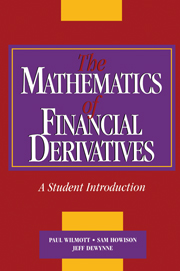9 - Methods for American Options
from Part Two - Numerical Methods
Published online by Cambridge University Press: 05 June 2012
Summary
Introduction
Using finite-difference methods for European options is relatively straightforward, as there is no possibility of early exercise. As we have seen, the possibility of early exercise may lead to free boundaries. The chief problem with free boundaries, from the point of view of numerical analysis, is that we do not know where they are. This makes it difficult to impose the free boundary conditions, since we have to determine where to impose them as part of the solution procedure. (Recall that in Chapter 8 we simply imposed the boundary conditions at fixed grid points.)
There are two distinct strategies for the numerical solution of free boundary problems. One is to attempt to track the free boundary as part of the time-stepping process. In the context of valuation of American options this is not a particularly attractive method, as the free boundary conditions are both implicit – that is, they do not give a direct expression for the free boundary or its time derivatives. We simply note the existence of such methods here, and refer the reader to the literature for a discussion of various boundary tracking strategies for implicit free boundary problems.
The other strategy is to attempt to find a transformation that reduces the problem to a fixed boundary problem from which the free boundary can be inferred afterwards. There are many transformations that do this, but we consider only the particularly elegant method involving the use of the linear complementarity formulation.
- Type
- Chapter
- Information
- The Mathematics of Financial DerivativesA Student Introduction, pp. 165 - 179Publisher: Cambridge University PressPrint publication year: 1995



